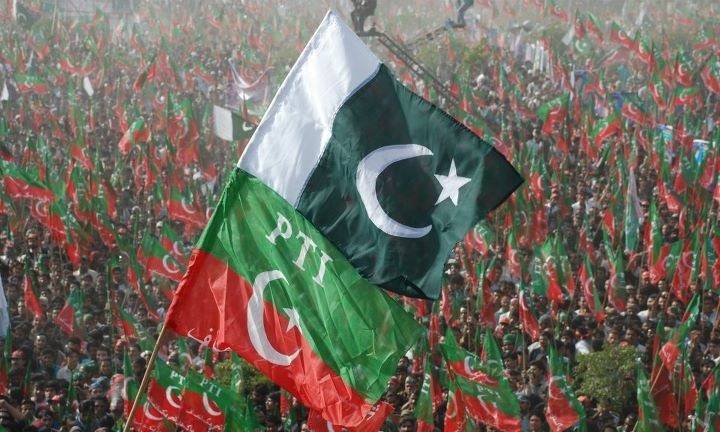The revolution is coming. Again. On August 7, the PTI has declared its intention to start a campaign of protests against the PML-N government, vowing to take out a march against the government every week until mid-term elections are held. By coordinating its attacks with other political parties, the PTI wants build a popular movement around the issue of the Panama Papers and the alleged corruption of the PML-N leadership. The irony of going down this path in tandem with the PPP, a party the PTI ceaselessly castigated for being hopelessly and inherently venal, seems to have been lost on the latter.
None of this is new. Two years ago, the PTI spearheaded a months long campaign against rigging in the 2013 elections, mobilising thousands of people in a relentless series of rallies and sit-ins. Then, Imran Khan’s frothy denunciations of the PML-N from atop a shipping container in Islamabad were accompanied by forms of protest that ran the gamut from the ridiculous to the sublime; half-baked calls to boycott the payment of taxes were made at the same time as more serious demands for substantive inquiries into misconduct in specific constituencies, and veiled appeals for military intervention came with ill-advised attacks on government buildings and offices. One judicial commission and several by-elections later, there is really nothing to show for all this sound and fury. The PML-N remains comfortably ensconced in power, and insult has been added to injury with the parties utter domination of local government elections in Punjab.
The persistence of the status quo, despite the PTI’s best efforts, raises important questions about the mechanisms underpinning the institutional reproduction of political power in Pakistan, but also about the organisational and strategic imperatives of the PTI’s approach to contestation and opposition. As i have argued before in this space, the internal factionalism currently tearing the PTI apart, with ‘electables’ clashing with an old guard of ideologically motivated activists and party workers, has militated against the formation and articulation of a coherent, programmatic party platform, while also undermining attempts to build the kind of party apparatus that would be required to effectively mobilise against rival parties that are deeply entrenched within the framework of the country’s politics.
Essentially, the PTI remains a party beset with contradictions. As an entity constantly promoting a narrative of change, it remains curiously wedded to employing the very same mechanisms through which power has historically been acquired in Pakistan. Electable politicians are able to mobilise their vote banks on the basis of their ability to work the levers of state patronage through their access to economic and bureaucratic power, with this in turn being premised on a continuation of the same kinds of rent-seeking and institutional dysfunction that the PTI ostensibly aims to reform. It should be self-evident that an electoral strategy premised on the cooptation of these actors will simply reproduce established systems of control and misgovernance, but the PTI continues to insist that the seizure of electoral power through these means will facilitate radical political outcomes. The problem is compounded by the nature of the PTI’s composition at the level of its leadership and membership. The ideological wing of the party, while disconnected from constituency politics, essentially represents an alternative faction of Pakistan’s elite, often leading it to propose policies and ideas that, while arguably ‘liberal’, do not necessarily represent a departure from the adherence to a model of capitalist economic development that produces the very same inequality and exclusion that the PML-N and other parties preside over. This, in turn, impacts the party’s ability to mobilise the subordinate classes in a way that would provide the PTI with the kind of mass support required to successfully challenge its rivals. Finally, the water is muddied even further by the party’s persistent ambivalence about the military’s role in politics, and the role of Islam in Pakistan’s public discourse.
The result of all this is a confused approach to politics, with the PTI lacking an ideological narrative geared towards building mass support, and a party machine not beholden to electables for the purpose of garnering votes. In that sense, the PTI bears a more than passing resemblance to the parties it opposes, bereft of a clear ideological identity and subject to capture by traditional economic and political elites.
This explains why the party remains incapable of challenging the PML-N in Punjab, and why its most recent campaign may ultimately be as inconclusive as its attempts in 2014. Corruption is obviously a problem in Pakistan, but the PTI simply lacks both the will and the means through which to effectively capitalise on any popular sentiment that could be mobilised against it. This is true independently of the fact that the PTI is also arguably structurally incapable of actually remedying the problems it identifies due to its own internal contradictions. Furthermore, while corruption is important, it is hardly the only issue that needs to be addressed in Pakistan. Roti, kapra, aur makaan was a potent message precisely because it touched upon issues the majority of the electorate confronted, and continue to confront, on a daily basis, and it is worth thinking about why the PTI remains incapable of embracing these kinds of issues in a more constructive and radical way.
This is unfortunate because the PML-N government has many shortcomings, and an effective opposition is necessary to keep it accountable in the interests of creating a more responsive and participatory democracy. However, as long as the PTI remains an inherently contradictory party, it will be unable to play this role.






